In this post, I’ll discuss the relationship between multi-flows and sparse cuts in graphs, bi-lipschitz embeddings into , and the weak differentiation of
-valued mappings. It revolves around one of my favorite open questions in this area, the planar multi-flow conjecture.
Table of contents:
- The max-flow/min-cut theorem
- Multi-commodity flows and sparse cuts
- The planar multi-flow conjecture
- Bi-Lipschitz embeddings into
- The planar embedding conjecture
- Parallel geodesics and the slums of geometry
- Local rigidity and coarse differentiation
- Beyond planar graphs
The max-flow/min-cut theorem
Let be a finite, undirected graph, with a mapping
assigning a capacity to every edge. If
is the set of all paths from
to
, then an
flow is a mapping
which doesn’t overload the edges beyond their capacities: For every edge
,
The value of the flow F is the total amount of flow sent: . A cut in
is a partition
which we will usually write as
. Naturally, one defines the capacity across
by
, where
is the characteristic function of
. Since one can only send as much flow across a cut as there is capacity to support it, it is easy to see that for any valid flow
and any cut
with
and
, we have
. The classical max-flow/min-cut theorem says that in fact these upper bounds are achieved:
where the maximum is over all flows, and the minimum is over all cuts
with
and
.
Multi-commodity flows and sparse cuts
We will presently be interested in multi-commodity flows (multi-flows for short), where we are given a demand function which requests that we send
units of flow from
to
for every
. In this case, we’ll write the value of a valid flow (i.e. one which doesn’t try to send more total flow than an edge can carry) as
where the minimum is over pairs with . So if the value of the flow is
, it means that every pair gets at least half the flow it requested (well, demanded).
Again, cuts give a natural obstruction to flows. If we define , where
is the total demand requested across
, then
for any valid flow
. Unfortunately, it is no longer true in general that
. (It is true as long as the demand is supported on a set of size at most 4, while it stops being true in general when the demand is supported on a set of size 5 or larger.)
In fact, the gap between the two can be arbitrarily large, as witnessed by expander graphs (this rather fruitful connection will be discussed in a future post). For now, we’ll concentrate on a setting where the gap is conjectured to be at most .
The planar multi-flow conjecture
It has been conjectured that there exists a universal constant such that if
is a planar graph (i.e. can be drawn in the plane without edge crossings), there is a
-approximate multi-commodity max-flow/min-cut theorem: For any choice of
and
, one has a
(1)
The conjecture first appeared in print here, but was tossed around since the publications of Linial, London, and Rabinovich and Aumann and Rabani, which recast these multi-flow/cut gaps as questions about bi-lipschitz mappings into (discussed next). Perhaps the most compelling reason to to believe the conjecture is the beautiful result of Klein, Plotkin, and Rao which shows that
for any planar instance where
(this is called a uniform multi-flow instance).
It is relatively easy to see that we cannot take , as the following example of Okamura and Seymour shows.
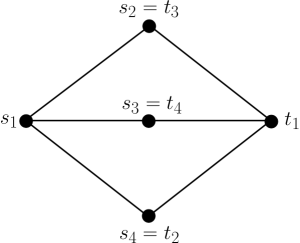
In the example, the non-zero demands are for
. It is easy to check that every cut has
, but the value of the maximum flow is only
, implying that
. If we use the same pattern on the complete bipartite graph
(instead of
), taking
shows that we must have
in (1). (Later a differentiation argument applied to a different family of graphs will show that we need
in (1).)
For any graph , define
as the smallest value
such that (1) holds for every choice of capacities and demands on
We will now see how
is determined by the geometric properties of path metrics defined on
Bi-Lipschitz embeddings into 
Consider a metric space , and the space of absolutely integrable functions
, equipped with the
norm. A mapping
is said to be
-bi-lipschitz if there exist constants
such that for all
,
and (so if
, then
is an isometry up to scaling). The infimal value of
for which
is
-bi-lipschitz is called the distortion of
. Define
as least distortion with which
maps into
.
We will now relate to the
-distortion of the geometries that
supports. Any set of non-negative weights
on the edges of
gives rise to a distance
on
defined by taking shortest-paths. Define
to be the maximum of
as
ranges over all such weightings. (Strictly speaking,
is only a pseudometric.)
Here is the beautiful connection referred to previously (see this for a complete proof).
Theorem (Linial-London-Rabinovich, Aumann-Rabani): For any graph ,
.
Metric obstructions. To give an idea of why the theorem is true, we mention two facts. It is rather obvious how a cut obstructs a flow. A more general type of obstruction is given by a metric on
. For any valid flow
,
(2)
To see why this holds, think of giving every edge a “length” of
, and having a cross-sectional area of
. Then the numerator in (2) is precisely the “volume” of the network, while the denominator is the total “volume” required to satisfy all the demands: By the triangle inequality, sending one unit of flow from
to
requires volume at least
. Observe that the bound (2) is a generalization of the cut upper bound when we define the pseudometric
for some
(this is called a cut pseudometric).
It turns out (by linear programming duality) that in fact metrics are the correct dual objects to flows, and maximizing the left hand side of (2) over valid flows, and minimizing the right-hand side over metrics yields equality (it is also easy to see that the minimal metric is a shortest-path metric). One might ask why one continues to study cuts if they are the “wrong” dual objects. I hope to address this extensively in future posts, but the basic idea is to flip the correspondence around: minimizing is NP-hard, while maximizing
can be done by linear programming. Thus we are trying to see how close we can get to the very complex object
, by something which is efficiently computable.
The cut decomposition of . Now that we see why metrics come into the picture, let’s see how
presents itself. Define a cut measure on a finite set
as a mapping
which satisfies
for every
.
Fact: Given , there exists a cut measure
on
such that
for every
. Conversely, for every cut measure
, there exists a mapping
for which the same equality holds.
Thus every -distance on a finite set is precisely a weighted sum of cut pseudometrics (and, of course, cuts are where this story began). Proving the fact is straightforward; first check that it holds for
, and then integrate. As an example, consider these two isometric embeddings, presented via their cut measures (the graphs are unit-weighted):
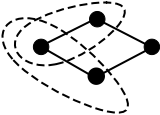
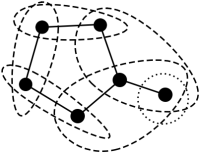
In the 4-cycle, each cut has unit weight. The corresponding embedding into maps the four vertices to
. In the second example, the dashed cuts have weight 1/2, and the dotted cut has weight 1. (Exercise: Verify that every tree embeds into
isometrically.)
Two comments are in order; first, when is finite, one can equivalently take the target space to be
equipped with the
norm (exercise: prove this using Caratheodory’s theorem). Thus one might ask why we would introduce a function space
in the first place. One reason is that the dimension is irrelevant; a deeper reason is that when
is infinite (in which case an appropriately stated version of the fact holds),
is the proper setting (and not, e.g.
). This arises, for instance, in arguments involving ultralimits in the passage between the finite and infinite settings.
The planar embedding conjecture
Using the connection with -embeddings, we can now state the planar multi-flow conjecture in its dual formulation.
Planar embedding conjecture: There exists a constant such that every shortest-path metric on a planar graph
admits a
-bi-lipschitz embedding into
.
By a relatively simple approximation argument in one direction, and a compactness argument in the other, one has the following equivalent conjecture.
Riemannian version: There exists a constant such that every Riemannian metric on the 2-sphere admits a
-bi-lipschitz embedding into
.
Recently, Indyk and Sidiropoulos proved that if it’s true for the 2-sphere, then it’s true for every compact surface of genus , where the constant
depends on
(as it must).
We can now state some known results in the dual setting of embeddings. Let be a planar graph, and let
be a shortest-path metric on
. The previously mentioned theorem of Klein, Plotkin, and Rao can be stated as follows: There exists a non-expansive mapping
such that
.
In Gromov’s language, the observable diameter of planar graph metrics is almost as large as possible (i.e. no forced concentration of Lispchitz mappings).
A classical theorem of Okamura and Seymour is stated in the embedding setting as: Let be a face in some drawing of
in the plane. Then there exists a non-expansive mapping
such that
is an isometry. In the flow setting, this says that if the demand function is supported on the pairs belonging to a single face, then (1) holds with
.
Finally, we mention the bound of Rao which shows that for planar metrics. A slightly more general version says that whenever the demand is supported on at most
pairs, the flow/cut gap can be at most
.
Read about the relationship with coarse differentiation after the jump.
Parallel geodesics and the slums of geometry
Of course there is an obvious parallel between taking a fixed graph and studying all the shortest-path metrics it supports, and considering the family of Riemannian metrics on a fixed manifold. Since graph theory is the “slums of topology,” I suppose this makes metric-graph theory the slums of differential geometry. (Fortuntately, in areas like coarse geometry, graphs are elevated to the level of equal partners.)
One fascinating question is how the structure of the geometries evolves as we allow the underlying graph to become more complex. It’s easy to understand the metrics supported on a path; they are all isometric to a subset of the real line. What if we allow more than one path between a pair of points?

(Consider the edges as having unit weights.) As we’ve seen, the first space embeds isometrically. It turns out that the middle graph requires distortion (the same as the flow gap we saw earlier), and if we put more and more parallel 2-paths, the distortion tends to
(look here for a short proof).
Is it possible that we can amplify this to unbounded distortion by being more clever? Consider the following operation on edges.

Certainly the operation preserves planarity. Starting with an initial edge, we could repeat this over and over again to get a graph like
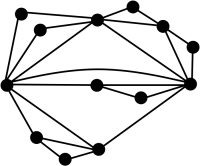
The metrics supported on such graphs are precisely the class of shortest-path metrics on series-parallel (SP) graphs. (Although these graphs themselves do not constitute all SP graphs, by appropriately weighting them, we do exhaust all metrics supported on SP graphs.)
Gupta, Newman, Rabinovich, and Sinclair showed that all such graphs embed into with distortion at most 14. A first approximation to their embedding can be described as follows: Follow the sequence of edge splittings backwards by mapping a “child” vertex onto one of the two parents at random (not necessarily uniformly). At the end, every vertex is mapped onto either the left or right endpoint of the initial edge. This yields a cut; the weight of the cut is proportional to the probability of producing it. This doesn’t quite work; one has to occasionally isolate a child from her parents.
It turns out (as we showed recently with Chakrabarti, Jaffe, and Vincent) that the right answer for this class of graphs is 2. For now, we move to the lower bound.
Local rigidity and coarse differentiation
The following argument arose in joint work with P. Raghavendra.
Consider , the path of length
. It is easy to check that every isometric embedding of the path into
induces exactly the same cut measure:

where the dotted lines represent cuts in the obvious way. The question now becomes: how stable is this property? What happens if is a mapping with distortion
? Obviously we cannot hope for a global conclusion (you can start adding all kind of crazy cuts to the isometry without affecting the distortion too much).
Local rigidity. Instead, think of . Given any
and
, I claim that there exists a large enough
such that in any distortion-
embedding
, the following happens. There exist points
such that
has distortion at most
. Moreover, if we look at the cut measure induced on Q by
, all but an
fraction of the weight is concentrated on cuts which occur in the isometric embedding, and the weight of each cut is right up to a factor of
. In other words, “locally” any low-distortion
embedding has to act almost like an isometry. In fact, this holds “almost everywhere,” in the sense that it can be made to hold for most values of
and
. I’ll sketch the proof of this after showing how it can be used to prove a better max-flow/min-cut gap in planar graphs.
This is not very surprising if you’ve seen e.g. Lebesgue’s differentiation theorem or Rademacher’s theorem. But the crucial fact here is that the conclusion of Rademacher’s theorem does not hold for mappings . In the language of geometric functional analysis,
fails to have the Radon-Nikodym property. (The usual example is to take the map
. Observe that this map is an isometry, but is not differentiable anywhere, since
.)
The lower bound graphs. Recall that is the complete
bipartite graph; we will think of
as having
disjoint 2-paths between a pair of points. Now replace every edge of
by a copy of
. If you did this with
, you would get:
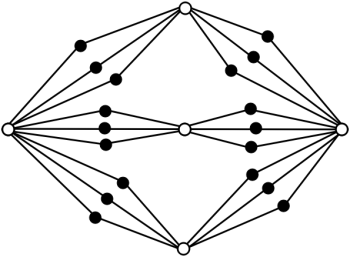
Let’s call the -fold repetition of this process
. Observe that the preceding graph has 6 small copies of
, but it also has a large metrical copy (consisting of the white nodes). In terms of offsets from the left and the notation above, we can describe the white copy by
and e.g. one of the small copies as
. The graphs
are known as diamond graphs.
The point now is to take and use the preceding local rigidity statement to find a “copy” of
so that
acts nearly isometrically on every 2-path in the copy. By setting
(with
), we can ensure that most of the cuts restricted to our copy of
are of the following form:
s 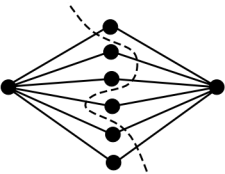 t
t
In other words, they separate from
(stated differently, restricted to any shortest
path, the cuts look like those coming from an isometry). Although
, it is fairly easy to see that any embedding consisting solely of cuts of this form must have distortion
as
, showing that if (1) holds, then it requires
. To see this, notice that every such cut has half the edges crossing it, but can separate at most half of the
middle pairs (well, slightly more than half which is why we have to take
). But edges have length 1, and the middle pairs are all separated by distance 2. The fact that these cuts treats edges and middle pairs the same (in terms of the fraction cut), implies that any embedding consisting of such cuts incurs distortion at least 2.
Coarse differentiation. Finally, we move to the proof of the local rigidity statement. This is based on the coarse differentiation technique of Eskin, Fisher, and Whyte. Given a mapping of the path of length
into an arbitrary metric space
, we say that
is
-efficient if
This is a discrete sort of bounded variation. The left-hand side holds trivially from the triangle inequality, and the right-hand side says that the triangle inequality isn’t too far off, i.e. the image is “almost straight.”
Let’s assume that for some
, and we’ll break
into scales: Scale
involves points which are multiples of
. The level-
segments are those portions of precisely
level-
points between two level-
points. See the following picture, where
, and the level 1, 2, and 3 segments are shown.

We would like to find a segment at some scale on which is
-efficient. The differentiation argument is now this: If
is
-efficient at level 1, stop (we found a good scale). Otherwise,
must be fairly non-straight at the first scale approximation:

Now if is
-efficient on one of the level-2 segments, stop (actually, we want this to hold for most of the segments, but the same argument works). If not,
must be fairly non-straight on the second scale segments:

And if we fail again to find a good segment at the next scale:

As the pictures expresses pretty clearly, every time we reveal that behaves badly on the next scale, our estimate on the length of
goes up. But
has bounded distortion, and thus the length of
cannot be too much bigger than the length of
. If there are enough scales, we eventually find a good one or reach a contradiction (and averaging shows, in fact, that at most scales, almost all the segments must be good lest we encounter a contradiction). It’s important to note that if we only used the fact that
is Lipschitz, we would not be able to get a definite increment in our estimate on the length of
at every step; this requires that
be bi-Lipschitz.
Specializing to embeddings. The argument of Eskin, Fisher, and Whyte works for any target metric space
. To get information about cuts, we specialize the preceding discussion to the case
.
Again consider the path . Call a cut
monotone if
is either a prefix or a suffix of the path
(in other words, at most one edge of
crosses
). Observe that monotone cuts are precisely those which have non-zero weight in the isometric embedding of
.
If is not a monotone cut, then it cuts at least two edges, hence we have the inequality
This shows that the mapping is at best
-efficient. But now consider a mapping
. We know that
decomposes as
for some cut measure
. Thus if
is
-efficient, then it must be that
has at most an
-fraction of its weight supported on non-monotone cuts.
So once we find a scale at which is
-efficient, we have strong control over the cut measure restricted to that scale, as was required for the distortion lower bound earlier.
Beyond planar graphs
The planar embedding conjecture is still open. It seems that if differentiation arguments are going to disprove it, they will have to use more than just local rigidity for paths (with some work, one can get local rigidity for grids, for instance, but then it’s hard to play around with full-blown grids without violating the topology).
If one is willing to work with a significantly more sophisticated (though still “finite-dimensional,” e.g. doubling) metric space, then a different sort of weak differentiation argument is able to show that there exists no bi-Lipschitz embedding into at all. Assaf Naor and I conjectured that such a lower bound holds for the 3-dimensional Heisenberg group
equipped with its Carnot-Caratheodory metric, in relation to the Goemans-Linial conjecture (this is a—now disproven—conjecture about the max-flow/min-cut gap for a significantly weaker notion of multi-commodity “flows”). The conjecture was proved by Cheeger and Kleiner, using local rigidity results of Franchi, Serapioni, and Serra Cassano for sets of finite perimeter in the Heisenberg group.
Hello admin, nice site ! Good content, beautiful design, thank !,
Amazing. Here’s a question, are there families of graphs with good separators but bad L_1-distortion?
Yes, for instance the 3-dimensional Heisenberg group mentioned at the end of the article. The results of Cheeger and Kleiner imply that grids in this group have unbounded distortion (as the size of the grid goes to infinity), but they have separators of size ~ sqrt{N}, where N is the number of points.